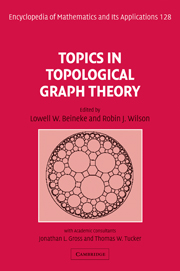Book contents
- Frontmatter
- Contents
- Foreword
- Preface
- Introduction
- 1 Embedding graphs on surfaces
- 2 Maximum genus
- 3 Distribution of embeddings
- 4 Algorithms and obstructions for embeddings
- 5 Graph minors: generalizing Kuratowski's theorem
- 6 Colouring graphs on surfaces
- 7 Crossing numbers
- 8 Representing graphs and maps
- 9 Enumerating coverings
- 10 Symmetric maps
- 11 The genus of a group
- 12 Embeddings and geometries
- 13 Embeddings and designs
- 14 Infinite graphs and planar maps
- 15 Open problems
- Notes on contributors
- Index
15 - Open problems
Published online by Cambridge University Press: 05 June 2012
- Frontmatter
- Contents
- Foreword
- Preface
- Introduction
- 1 Embedding graphs on surfaces
- 2 Maximum genus
- 3 Distribution of embeddings
- 4 Algorithms and obstructions for embeddings
- 5 Graph minors: generalizing Kuratowski's theorem
- 6 Colouring graphs on surfaces
- 7 Crossing numbers
- 8 Representing graphs and maps
- 9 Enumerating coverings
- 10 Symmetric maps
- 11 The genus of a group
- 12 Embeddings and geometries
- 13 Embeddings and designs
- 14 Infinite graphs and planar maps
- 15 Open problems
- Notes on contributors
- Index
Summary
We present a variety of open problems in topological graph theory, ranging through classical questions on genus, map colourings, crossing numbers, and geometrical representations. We also consider algorithmic questions and infinite graphs.
Introduction
We all have our problems. In this chapter I present some of my favourite ones in topological graph theory. Some of these come from a problem list [3] I have been maintaining at http://www.cems.uvm.edu/~archdeac/problems, others are new; all, I think, are interesting. A. N. Whitehead said ‘The “silly” question is the first intimation of some totally new development’; I hope that some of these questions are silly.
In Section 2 we give some problems on drawing graphs in the plane, including the number of crossings. Section 3 contains some classical problems on genus and on obstructions to embeddings. In Section 4 we turn our attention to finding cycles, factors and trees in embedded graphs. A look at colouring and flow problems is in Section 5, while Section 6 examines problems involving local planarity, also known as representativity. Section 7 then covers the thickness of graphs, book embeddings and planar covers. Other geometrical topics are studied in Section 8, and algorithmic problems in Section 9. We finish in Section 10 with a look at infinite graphs.
We give a small sample of open and (we hope) interesting problems in topological graph theory. You are invited to explore the literature, the web and your imagination for others.
Information
- Type
- Chapter
- Information
- Topics in Topological Graph Theory , pp. 313 - 336Publisher: Cambridge University PressPrint publication year: 2009
Accessibility standard: Unknown
Why this information is here
This section outlines the accessibility features of this content - including support for screen readers, full keyboard navigation and high-contrast display options. This may not be relevant for you.Accessibility Information
- 2
- Cited by
